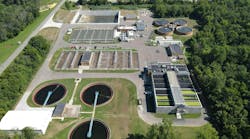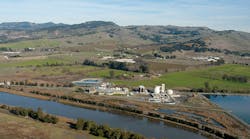The Logan Township, New Jersey, water reclamation facility managed by Logan Township Municipal Utilities Authority (LTMUA) is located in the center of the town’s environmental reserve, surrounded on all four sides by wetland buffers.
Located on the Delaware River banks, officials in Logan Township, New Jersey, have long sought to preserve the area’s watershed and natural environment.
LTMUA Water Reclamation Plant History
In the early 1970s, the township designed the Pureland Industrial Complex, described as the nation’s first ecologically-planned industrial complex. Additionally, it set aside 1,200 acres of environmental reserve. Wastewater treatment at the facility is from both Logan Township and nearby Woolwich Township and serves approximately 7,000 people.
The plant has a 1.4 million gallons per day (mgd) average and peak 2.6 mgd flow that is equalized, said Chris Whalen, superintendent and licensed operator with LTMUA.
In 2015, the LTUMA plant was operating well within its existing 2 mgd capacity, provided by two contact stabilization tanks rated at 0.5 mgd each and a two-tank OMNIFLO sequencing batch reactor (SBR) system from Evoqua rated at 0.5 mgd per tank.
At the same time, the town was anticipating a significant increase in flow from nearby industrial parks where new food processing and warehouse facilities were expected to bring high treatment requirements.
Expanding to Meet Needs
Logan Township recently expanded the capacity of its water reclamation facility by 25% with the OMNIFLO SBR system.
LTMUA worked with the New Jersey Department of Environmental Protection (NJDEP) and Remington & Vernick Engineers (RVE) of Cherry Hill, New Jersey to plan a 0.5 mgd expansion of the SBR process that would meet growth needs while preserving the quality of the surrounding wetlands.
RVE provided design engineering services as well as material shop drawing reviews. One critical concern was the location of the proposed third SBR tank.
Tight buffer zones meant space was at a premium. Additionally, height was a concern due to potential interference with the flight paths of wetland birds, including bald eagles.
Past reports had identified one of the plant’s polishing lagoons as a potential site for the proposed third SBR tank.
After consideration of environmental and operational aspects discussed at a meeting of project stakeholders, the NJDEP favored locating the proposed SBR in a different location near the two existing SBRs.
This meant wedging a third SBR tank and its control systems into a narrow strip of land at the end of the facility property.
Installing the Sequencing Batch Reactor
The compact, high-efficiency design of the Evoqua OMNIFLO SBR system helped meet the challenges. The system has been designed to treat wastewater in plants ranging from 0.01 to 60 mgd.
As a batch process, the OMNIFLO SBR system accomplishes equalization, aeration, and clarification in the relatively small footprint of a single reactor basin. With advanced control systems that automate key processes, SBR systems enable precise, flexible management of the treatment process to support efficient biological nutrient removal (BNR) of ammonia nitrogen, total nitrogen and phosphorus.
Each SBR system equalizes, aerates, settles and decants the flow in a timed sequence in a single batch operation.
Operators can achieve simultaneous nitrification, denitrification and biological phosphorus removal by varying the conditions from aerobic to anaerobic to anoxic.
RVE specified the LMTUA expansion tank to be rectangular in order to maximize land utilization at the site. That was augmented by Evoqua's product experts providing process knowledge and expertise to help deliver an SBR solution meeting LMTUA’s space and performance requirements.
The expansion tank was constructed with the same flow rating as the other two SBRs but with increased water volume to treat higher strength wastes with elevated biochemical oxygen demand and chemical oxygen demand concentrations typical of those discharged from food industry facilities. Additionally, RVE specified high-efficiency motors and lighting throughout the project to help meet sustainability goals.
The plant’s capacity is now 2.5 mgd and average daily flow is approximately 1.4 mgd, a 25% increase over the last five-year span, leaving room for the future. Overall SBR treatability has increased due to the higher pollutant strength loading capability of the expansion SBR.
The expansion is meeting strict potential effluent limits of 5 ppm biochemical oxygen demand (BOD), 5 ppm total suspended solids (TSS), 3 ppm nitrogen and 1 ppm phosphorus.
Better Handle on Wet Weather
With three operational SBRs, the ability to feed at least one SBR at any one time reduces the detention in the plant’s equalization tank during wet weather events. The wet stream path of the water flows through screening facilities, aerated grit facilities, and an influent lift station to a 740,000-gallon equalization tank.
It is split into two 0.5 mgd contact stabilization tanks by valved-controlled gravity feed or three 0.5 mgd SBR tanks by periodic pumping from the intermediate pump station after the SBRs have completed both their individualized decant (batch effluent discharge) and waste sludge removal cycles.
The contact stabilization tanks and SBR tank effluent discharge to effluent lagoons for flow calming purposes. The system also includes filtration, ultraviolet disinfection and an effluent lift station, said Richard Czekanski, PE, BCEE, CME with Remington & Vernick Engineers.
Currently, loading and temperature conditions vary throughout the year, which has an effect on treatment, but with average influent BOD at 652 mg/L and average influent TSS at 703 mg/L, the three tank SBR system possesses some idle time but are utilized to their fullest extent, Czekanski said.
A new plant effluent pump station along with three miles of 21-inch diameter HDPE effluent outfall piping for flow conveyance to the Delaware River was put into service in 2022. And more upgrades are on the way.
“Currently, a new replacement headworks – screening and grit – facility and influent pump station are being designed,” Whalen said.
The project’s combination of land utilization, wetlands protection, the maintenance and operation of the existing facilities during construction and energy conservation earned Remington & Vernick Engineers the American Academy of Environmental Engineers & Scientist’s the 2021 National Grand Prize for Excellence in Environmental Engineering and Science Awards Competition – Design Category.


